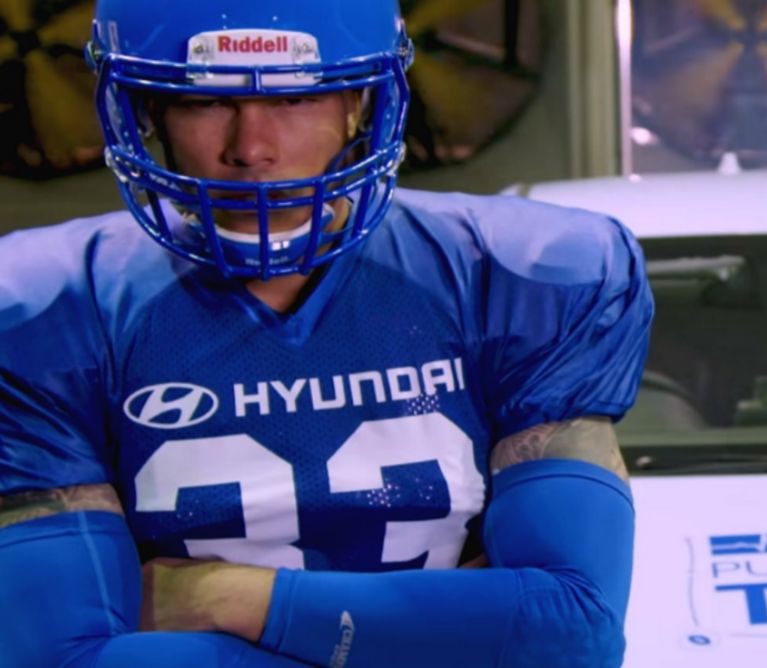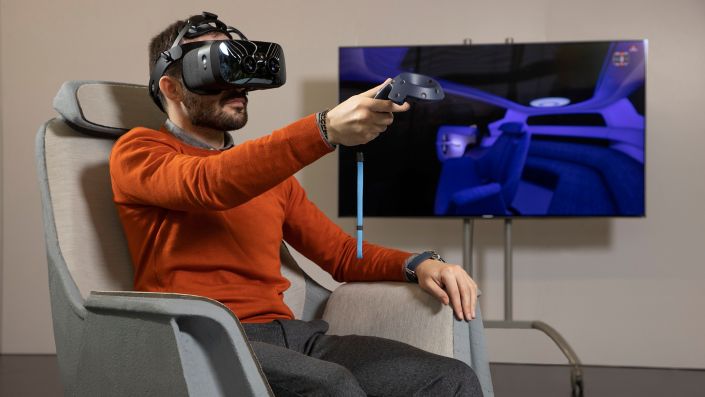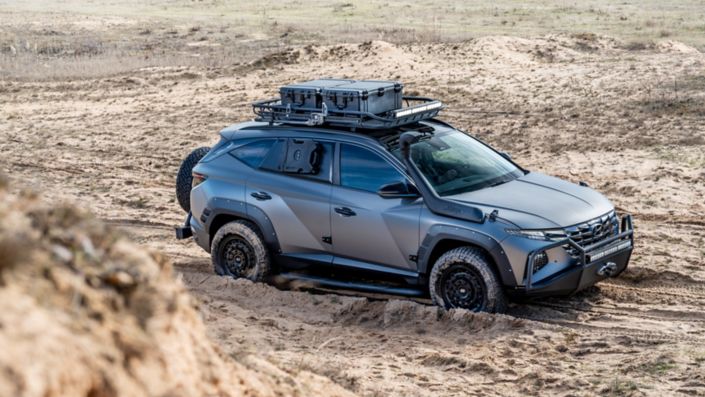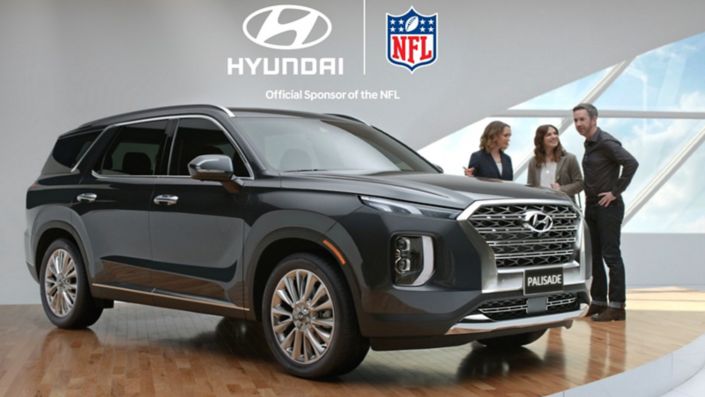As one of the world’s most popular sporting leagues, the NFL has turned determination into a science and performance into an art, taking every opportunity to get stronger, faster, better. Hyundai Motor shares this passion for progress, which is why it is proud to be the Official Sponsor of the NFL.
When you’re ready for anything, you can take every obstacle in your stride. That’s why the NFL's stars train from sunrise to sunset, and it’s why every Hyundai is tested in extreme conditions before it hits the road.
Hyundai wanted to see how tough NFL players are by creating a series of challenges for them in our own testing environment. Do they have skills on the skid pan, can they complete the ultimate IQ test during a brain freeze and can they perform under the high pressure elements of the wind tunnel?
There’s only one way to find out. Get ready for Hyundai versus the NFL!
First up, the skid-pan – a specially prepared surface on which drivers can practise controlling skids, and where a car’s handling is pushed to the limit. Its sprinklers coat an already slick surface with water, making it the ultimate test of traction.
Representing Hyundai: the i20 Coupe. As well as its Front McPherson strut type suspension that delivers superior handling and comfort, the i20’s electronic stability control (ESC) automatically distributes optimum brake force to each wheel based on engine torque and driving circumstances, while its vehicle stability management (VSM) enables the car to maintain maximised stability and safety when driving in potential skidding situations.
Representing the NFL: Jason Bell, former star cornerback for the Dallas Cowboys, the Houston Texans and the New York Giants, who was famed for his agility and quick change of direction. In his very first NFL season, Bell led the Cowboys in special teams tackles with 21, a feat he would repeat in his first season with the Texans.
When you’re ready for anything, you can take every obstacle in your stride. That’s why the NFL's stars train from sunrise to sunset, and it’s why every Hyundai is tested in extreme conditions before it hits the road.
Hyundai wanted to see how tough NFL players are by creating a series of challenges for them in our own testing environment. Do they have skills on the skid pan, can they complete the ultimate IQ test during a brain freeze and can they perform under the high pressure elements of the wind tunnel?
There’s only one way to find out. Get ready for Hyundai versus the NFL!
The Skid-Pan
First up, the skid-pan – a specially prepared surface on which drivers can practise controlling skids, and where a car’s handling is pushed to the limit. Its sprinklers coat an already slick surface with water, making it the ultimate test of traction.
Representing Hyundai: the i20 Coupe. As well as its Front McPherson strut type suspension that delivers superior handling and comfort, the i20’s electronic stability control (ESC) automatically distributes optimum brake force to each wheel based on engine torque and driving circumstances, while its vehicle stability management (VSM) enables the car to maintain maximised stability and safety when driving in potential skidding situations.
Representing the NFL: Jason Bell, former star cornerback for the Dallas Cowboys, the Houston Texans and the New York Giants, who was famed for his agility and quick change of direction. In his very first NFL season, Bell led the Cowboys in special teams tackles with 21, a feat he would repeat in his first season with the Texans.
Press material
NFL players are some of the fastest, strongest and most athletic sportsmen in the world. But are they tough enough to perform under the extreme conditions every Hyundai car are tested in?
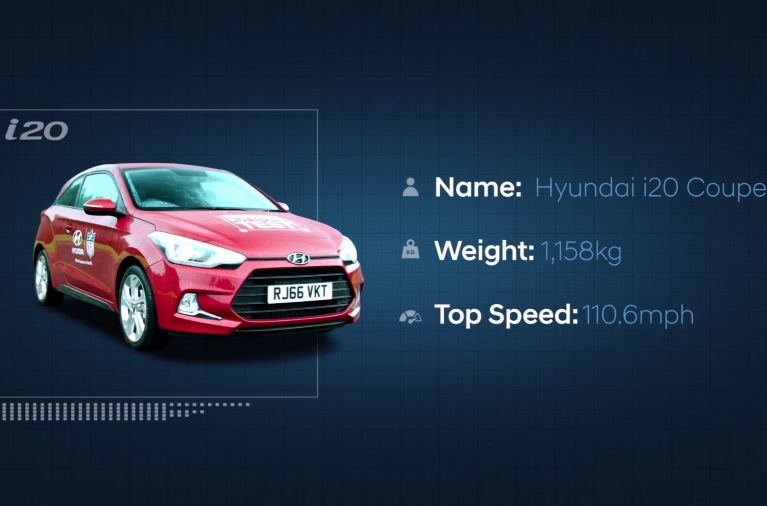
Winner: The Hyundai i20. While Jason struggled to stay on his feet as he traversed a course of cones laid out on the skid pan, the i20 glided through them with ease. To be fair, Bell never stood a chance: during its development the i20 undertook rigorous testing at the Nürburgring, home to Hyundai’s European Test Centre.
Six professional test drivers repeatedly pushed it close to the limit on the 20.8-kilometre track, assessing numerous key parameters, including handling and suspension. Like all Hyundai cars, it lapped the world-famous Nürburgring 480 times in both dry and wet conditions, simulating up to 180,000 km of severe driving – the equivalent to a normal vehicle’s lifecycle – in just four to six weeks.
Next in line is the climate chamber – an air-tight facility designed to test how a car can withstand extreme environmental conditions. It can simulate a full range of real-world conditions, including air and road temperatures, wind speeds and humidity levels.
Representing Hyundai: the Santa Fe. With dual-zone adjustable automatic climate control that allows front seat occupants to create and maintain their own comfort zones, heated and ventilated seats for welcoming warmth in winter or a cooling effect in summer, an auto defogging system that activates automatically when windscreen condensation is detected to restore and maintain visibility and heating elements in the base of the windscreen to quickly defrost frozen wiper blades, the Santa Fe is fully weatherproof.
Representing the NFL: Jason Bell. Jason is one tough cookie, having played his first three games for the Houston Texans with a fractured wrist and four games for the New York Giants with a fracture forearm. But is he mentally strong enough to withstand the climate chamber’s sub-zero temperatures.
Six professional test drivers repeatedly pushed it close to the limit on the 20.8-kilometre track, assessing numerous key parameters, including handling and suspension. Like all Hyundai cars, it lapped the world-famous Nürburgring 480 times in both dry and wet conditions, simulating up to 180,000 km of severe driving – the equivalent to a normal vehicle’s lifecycle – in just four to six weeks.
The Climate Chamber
Next in line is the climate chamber – an air-tight facility designed to test how a car can withstand extreme environmental conditions. It can simulate a full range of real-world conditions, including air and road temperatures, wind speeds and humidity levels.
Representing Hyundai: the Santa Fe. With dual-zone adjustable automatic climate control that allows front seat occupants to create and maintain their own comfort zones, heated and ventilated seats for welcoming warmth in winter or a cooling effect in summer, an auto defogging system that activates automatically when windscreen condensation is detected to restore and maintain visibility and heating elements in the base of the windscreen to quickly defrost frozen wiper blades, the Santa Fe is fully weatherproof.
Representing the NFL: Jason Bell. Jason is one tough cookie, having played his first three games for the Houston Texans with a fractured wrist and four games for the New York Giants with a fracture forearm. But is he mentally strong enough to withstand the climate chamber’s sub-zero temperatures.
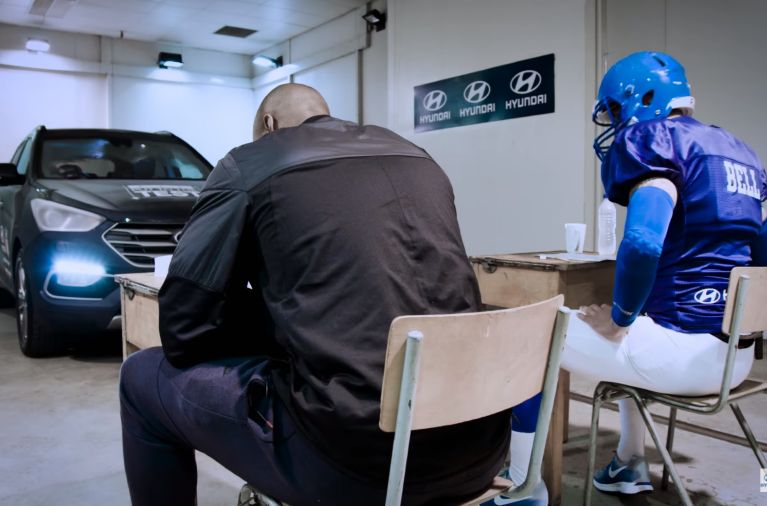
Winner: The Hyundai Santa Fe. Despite being dressed in full NFL uniform, padding and helmet, Jason struggled to complete an IQ test under the pressure of the freezing cold, and was only too glad to be able to recover in the toasty heat of the Santa Fe’s climate control.
Once again, the cards were stacked against Bell: as well as testing on the Nürburgring race track, Hyundai undertakes additional extreme weather trials from sub-zero locations in the coldest winter climates of Sweden, Finland and Russia, to the searing heat of southern Spain. This ensures its vehicles will still perform in severe conditions, such as blizzards, lightning, ice storms and dust storms.
These tests evaluate component performance and the vehicle’s functionality during prolonged extreme conditions. Hyundai tests also include a chamber that can generate a piping hot 60˚C, and one that can create 7cm of snow in an hour, helping to give the Santa Fe a working temperature of -30˚C to +40˚C.
Lastly, the wind tunnel – a testing chamber that uses turbines to project a stream of air towards an anchored-down car and simulate the conditions it would encounter when driven forward. Computers measure the amount of drag the car generates by the amount of force it exerts on its wheels, helping manufacturers improve aerodynamics.
Representing Hyundai: the All-New i30 N. Born in Namyang, Hyundai Motor’s global R&D Centre in Korea, honed at the Nürburgring, and providing up to 275 HP with high-performance cornering capabilities, it represents the ultimate driving experience on winding roads. The i30 N is aerodynamically designed to reduce lift to keep the body firmly on to the road when maximum traction is required.
Representing the NFL: Jason Bell. With the NFL season played over the US winter, Jason is used to facing all kinds of turbulent weather. However, he might not have experienced the kind of conditions that the wind tunnel can generate.
Once again, the cards were stacked against Bell: as well as testing on the Nürburgring race track, Hyundai undertakes additional extreme weather trials from sub-zero locations in the coldest winter climates of Sweden, Finland and Russia, to the searing heat of southern Spain. This ensures its vehicles will still perform in severe conditions, such as blizzards, lightning, ice storms and dust storms.
These tests evaluate component performance and the vehicle’s functionality during prolonged extreme conditions. Hyundai tests also include a chamber that can generate a piping hot 60˚C, and one that can create 7cm of snow in an hour, helping to give the Santa Fe a working temperature of -30˚C to +40˚C.
The Wind Tunnel
Lastly, the wind tunnel – a testing chamber that uses turbines to project a stream of air towards an anchored-down car and simulate the conditions it would encounter when driven forward. Computers measure the amount of drag the car generates by the amount of force it exerts on its wheels, helping manufacturers improve aerodynamics.
Representing Hyundai: the All-New i30 N. Born in Namyang, Hyundai Motor’s global R&D Centre in Korea, honed at the Nürburgring, and providing up to 275 HP with high-performance cornering capabilities, it represents the ultimate driving experience on winding roads. The i30 N is aerodynamically designed to reduce lift to keep the body firmly on to the road when maximum traction is required.
Representing the NFL: Jason Bell. With the NFL season played over the US winter, Jason is used to facing all kinds of turbulent weather. However, he might not have experienced the kind of conditions that the wind tunnel can generate.
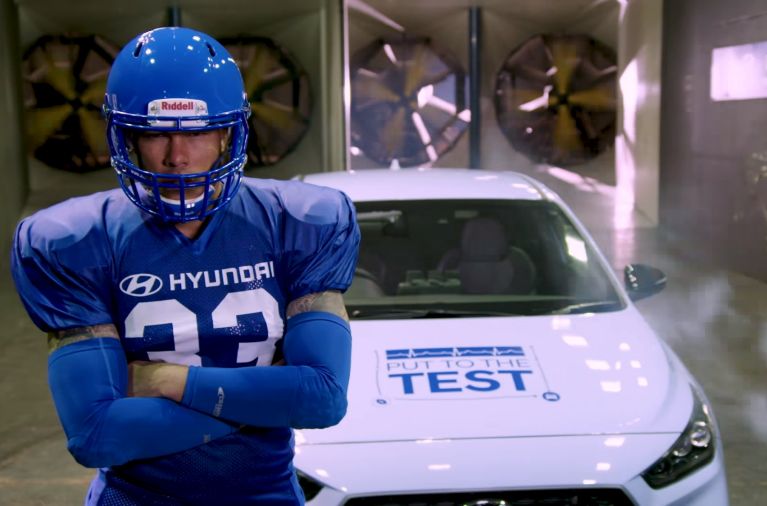
Winner: The Hyundai i30 N. The powerful airstream proved very hard for Jason to perform in, making passes almost impossible to catch and the football unpredictable when thrown. The i30 N, meanwhile, was unaffected.
You won’t be surprised to hear that the Hyundai had another huge advantage. The i30 N’s great road holding is the result of months of testing the aerodynamics at Hyundai’s Namyang Technology Research Centre and its aero-acoustic wind tunnel.
According to the principle “form follows function”, designers worked closely with aerodynamic specialists to define the right ratio between the i30 N’s downforce, drag and aerodynamics to create the best possible driving experience. The resulting lowered body together with the newly designed aerodynamics give the car its sporty silhouette and strong stance, while enhancing road balance and race track capabilities.
You won’t be surprised to hear that the Hyundai had another huge advantage. The i30 N’s great road holding is the result of months of testing the aerodynamics at Hyundai’s Namyang Technology Research Centre and its aero-acoustic wind tunnel.
According to the principle “form follows function”, designers worked closely with aerodynamic specialists to define the right ratio between the i30 N’s downforce, drag and aerodynamics to create the best possible driving experience. The resulting lowered body together with the newly designed aerodynamics give the car its sporty silhouette and strong stance, while enhancing road balance and race track capabilities.

